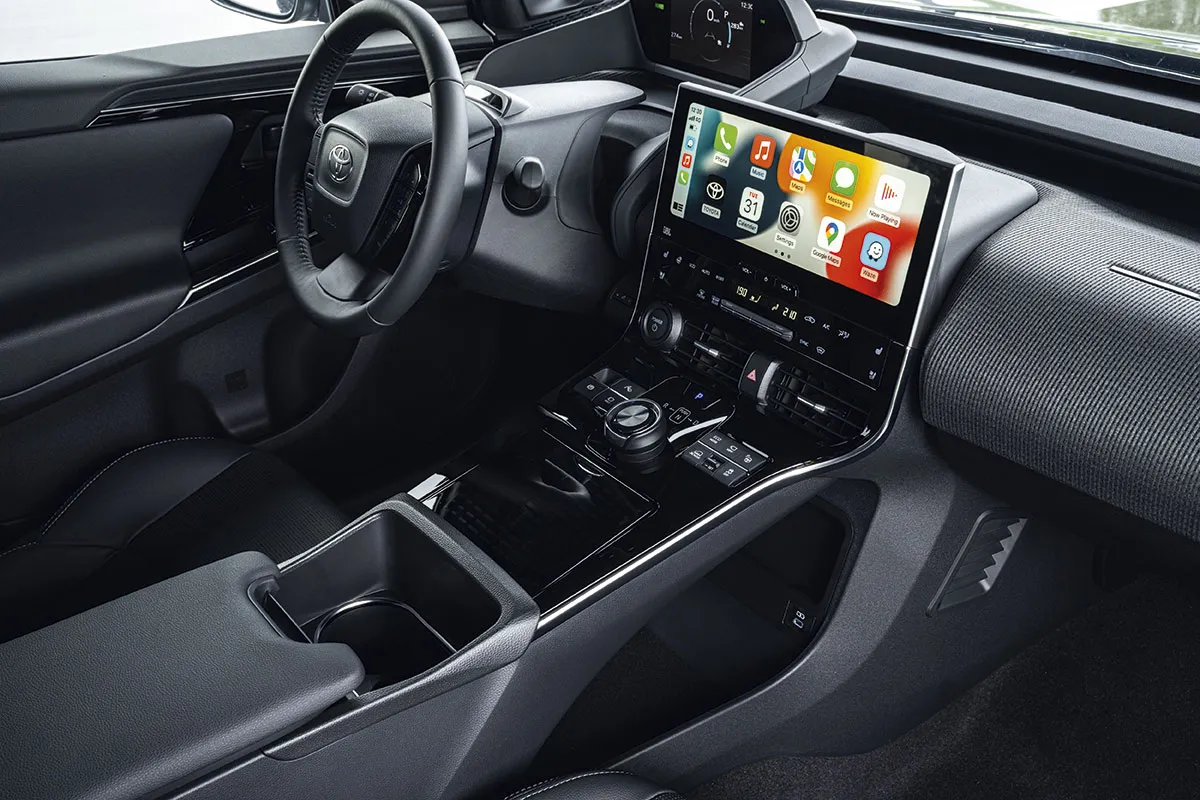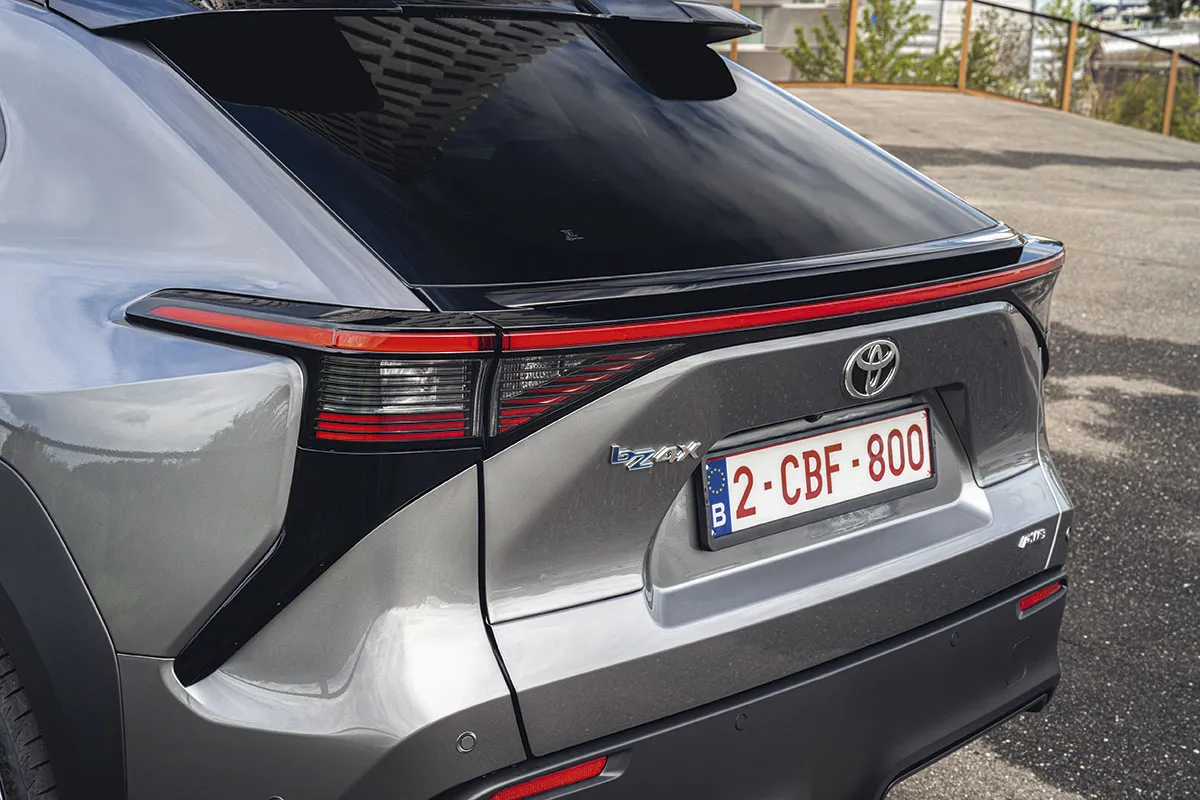Toyota isn’t afraid to try new things. It made hybrid cars popular with the Prius, it sold the first commercial hydrogen car with the Mirai, and it’s now working with the Japanese space agency (JAXA) to put the first proper car on the Moon – one that you won’t need to wear a spacesuit to drive. So it feels odd that it’s taken so long for the company to launch its first electric car, the BZ4X.
What’s was the hold-up? Well, from the outside looking in, it seems Toyota was hoping that motorists would back hydrogen power. It’s clear to see why: with a hydrogen fuel cell there’s no range anxiety and you refill your tank in largely the same way you do now. Unfortunately, the infrastructure (the refuelling stations) didn’t arrive in time to match Toyota’s ambitions.
The BZ4X isn’t Toyota throwing in the towel on hydrogen; it’s bridging the gap until hydrogen becomes a more viable option in the future – we think. So is Toyota’s pioneering spirit alive and well in its first battery-power-only car?
The answer is a muddy one. This is a good electric car, it’s fun to drive and offers tonnes of space with a smooth ride. Plus, the four-wheel-drive model (4WD) has some pretty smart all-terrain tech to help you when the road runs out. The BZ4X will wade through water, creep down steep verges and skip over rocky surfaces with an easy confidence. The interior has had a modern makeover too, with a clean, sleek finish that’s an upgrade over the more utilitarian cabin you’d normally find in a Toyota.
All-in-all, this car embodies Toyota’s sensible, practical side – what’s missing is the company’s fun-loving, experimental spirit. The kind of thinking that came up with the i-Road, a lovable three-wheeler electric trike built as a way to curb congestion and air pollution.
First off, let’s start with the name: BZ4X. The first bit stands for Beyond Zero, the 4 signifies the size (presumably there’ll be a BZ3 or 5 in the future) and X means it’s an SUV/crossover, just like every other new electric car these days. Functional, but clumsy.

Fortunately, no one buys a car based on its name, so what’s it like on the road? We took the 4WD model (there’s also a front-wheel drive (FWD) model) for a few hours around Copenhagen’s busy centre, and around a small off-road course to find out.
In the driver’s seat the steering wheel is compact and sporty. The combo of a lofty driving position and small wheel means that the digital dashboard can be obscured – you sometimes have to peek over or around the wheel to see what’s going on. The 215bhp motors are split between either end, making the BZ4X quick off the mark. Meanwhile, the low centre of gravity – thanks to the batteries spread out across the floor of the car – mean that it’s agile and taut around corners. It’s as fun to drive as an electric SUV can be.
The cabin is spacious and suitably techy, with a big central touchscreen and a console lit up with controls. Everything’s sensibly proportioned and ergonomic, as you’d expect from a Toyota. Above all else, the ride is seriously impressive. The BZ4X wafts over potholed city roads and country lanes without fuss, despite the weight of its batteries and thin, low-resistance tyres.
The rear seats are big and spacious – you won’t have kids kicking you in the back – compared to competitors that tend to struggle to squeeze in batteries and keep the rear cabin roomy. The 412-litre boot is what you’d expect to find on an EV this size, with storage below for the charging cables.

The all-important figure, the range, is nothing spectacular. At 317 miles (510km) for the FWD model and 286 miles (460km) on the 4WD model, it’s in line with its competition. Though as with all EVs, in the real world you can expect a chunk less than that.
Off-road, the car’s X-terrain tech is a fun addition that made light work of the course laid out for us: some ultra-steep ramps were set up so that the car would have only two wheels in contact with the ground at a given moment. We were also invited to drive through a small pool of water to prove it could wade. Both scenarios are unlikely for most UK drivers, but it’s nice to see some of Toyota’s all-terrain DNA at play.
There is one place where Toyota’s trademark playfulness does appear: two small winglets jutting out of the back of the roof that act as a small spoiler or “bunny ears” as the car’s assistant chief engineer joyfully shared with me. They’re a neat piece of design flair on a handsome but otherwise anonymous-looking car. It’s this sense of fun that means Toyota is more than just a company that makes affordable cars, and it’s the one thing that its first battery-powered car could have done with more of.
Read more about cars:
- Future cars: 9 designs that could revolutionise the vehicle industry
- Flying cars take off: How air taxis are about to revolutionise how we travel
- Electric cars: What can we do with the growing number of dead batteries?
Toyota BZ4X Premiere Edition: The facts
Price: £51,550
Drive: 4WD
Range: 286 miles
Battery/motor: 71.4kWh battery with front and rear 80KW electric motors
Max charge rate: 150kW
0-62MPH: 6.9 seconds
Top speed: 100mph (160km/h)
